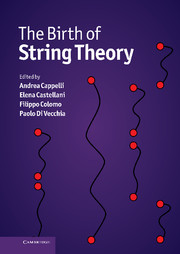Book contents
- Frontmatter
- Contents
- List of contributors
- Photographs of contributors
- Preface
- Abbreviations and acronyms
- Part I Overview
- EARLY STRING THEORY
- Part II The prehistory: the analytic S-matrix
- Part III The Dual Resonance Model
- Part IV The string
- TOWARDS MODERN STRING THEORY
- Part V Beyond the bosonic string
- Part VI The superstring
- Part VII Preparing the string renaissance
- 42 Introduction to Part VII
- 43 From strings to superstrings: a personal perspective
- 44 Quarks, strings and beyond
- 45 The rise of superstring theory
- Appendix A Theoretical tools of the Sixties
- Appendix B The Veneziano amplitude
- Appendix C From the string action to the Dual Resonance Model
- Appendix D World-sheet and target-space supersymmetry
- Appendix E The field theory limit
- Index
44 - Quarks, strings and beyond
from Part VII - Preparing the string renaissance
Published online by Cambridge University Press: 05 May 2012
- Frontmatter
- Contents
- List of contributors
- Photographs of contributors
- Preface
- Abbreviations and acronyms
- Part I Overview
- EARLY STRING THEORY
- Part II The prehistory: the analytic S-matrix
- Part III The Dual Resonance Model
- Part IV The string
- TOWARDS MODERN STRING THEORY
- Part V Beyond the bosonic string
- Part VI The superstring
- Part VII Preparing the string renaissance
- 42 Introduction to Part VII
- 43 From strings to superstrings: a personal perspective
- 44 Quarks, strings and beyond
- 45 The rise of superstring theory
- Appendix A Theoretical tools of the Sixties
- Appendix B The Veneziano amplitude
- Appendix C From the string action to the Dual Resonance Model
- Appendix D World-sheet and target-space supersymmetry
- Appendix E The field theory limit
- Index
Summary
In this Chapter, I recall the sequence of ideas which led to noncritical strings and gauge/strings duality. I also comment on some promising future directions.
In the Sixties I was not much interested in string theory. The main reason for that was my conviction that the world of elementary particles should allow a field theoretic description and that this description must be closely analogous to the conformal bootstrap of critical phenomena. At the time such views were very far from the mainstream. I remember talking to one outstanding physicist. When I said that boiling water may have something to do with the deep inelastic scattering, I received a very strange look. I shall add in the parenthesis that this was the beginning of a long series of ‘strange looks’ which I keep receiving to this day.
Another reason for the lack of interest was actually a lack of ability. I could not follow the very complicated algebra of the early works on string theory and did not have any secret weapon to struggle with it. On the other hand, the Landau Institute, to which I belonged, was full of the leading experts in condensed matter physics. I remember that in the late Sixties to early Seventies Tolya Larkin and I discussed (many times) whether Abrikosov's vortices could be viewed as elementary particles.
- Type
- Chapter
- Information
- The Birth of String Theory , pp. 544 - 551Publisher: Cambridge University PressPrint publication year: 2012
- 1
- Cited by



